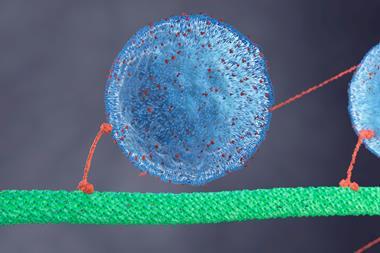From Ronald Bentley
In his ’Bench Monkey’ column (Chemistry World, April 2007, p40) Dylan Stiles notes that the odour of benzylmercaptan, used by a colleague, stays with him long after he leaves the lab. In 1989, I worked with the many reports describing the war-time research on the chemistry of penicillin at the USA National Archives. One box of these reports had the characteristic odour of benzylmercaptan. This reagent had been widely used for the synthesis of penicillamine during the penicillin project. Since the records were deposited in the National Archives around 1946, the odour had persisted for more than 40 years.
R Bentley MRSC
Pittsburgh, US
From Ralph Wilkins
Reading Dylan Stiles’ article (Chemistry World, May 2007, p42) on chemical experiments by youngsters in days of yesteryear reminded me of my evacuation in the UK in 1940, with King Edward VI Grammar School, from Southampton to Poole. I was lucky to be billeted with a wonderful couple. The fact that they were the parents of Mr. Whitelock, the chemistry master at Poole Grammar School, undoubtedly helped in their toleration of the experiments that an aspiring chemist undertook in their kitchen. I was allowed to heat iron filings with sulfur and add acid to the cold product. I could watch the glow of hot magnesium ribbon to simulate the fire bombs being randomly showered upon us at that time. I was permitted to tap very small quantities of the evaporate from iodine dissolved in aqueous ammonia. I am not certain now where I obtained some of the chemicals, but a chemistry set then was a veritable treasure trove.
I feel sorry for present day young students who are deprived of the fun of experiencing these colour changes, smells and minor bangs. This, I am certain, was part of the magic and attraction of chemistry to my and older generations. One weapon in the recruitment armoury has been lost.
R G Wilkins MRSC
Las Cruces, New Mexico, US
From M C Morris
In 1952 I was 12 years old, and often purchased concentrated sulfuric, nitric and hydrochloric acid from pharmacies. For an extra penny they supplied a rubber bung instead of a cork, which was no match for nitric acid on a long bus journey home. Iodine crystals, 880 ammonia and phenol were other regular purchases, while potassium chlorate and calcium carbide (from the cycle shop, used by us for making acetylene bombs) were also popular. However, we couldn’t buy potassium cyanide, used to kill off wasp nests, until we were 16 years of age.
We used my dad’s shed as a laboratory for a while. One Saturday, hydrogen chloride escaped in mass volumes, causing my dad’s tools to corrode. He made me dig a hole in the garden and bury all my bottles and cans of reagents - including a bottle of mercury. They were heady days.
M C Morris
Cheshire, UK
From John Garratt
The correspondence about human exhalation of carbon dioxide has got the issue out of perspective. Adult animals (including humans) operate at constant body mass; retaining 0.1 per cent of daily intake of food would be a real problem for most adult humans. It follows that almost all the carbon we ingest is exhaled as carbon dioxide, with smaller amounts being lost in urine and faeces.
Since the ultimate source of the carbon in food is the product of photosynthesis, it follows that the amount of carbon dioxide exhaled by humans is roughly balanced by the amount fixed by the requisite photosynthesis.
Unfortunately, the processes of modern industrial agriculture, food processing, and transport generate huge quantities of carbon dioxide. Figures from the 1970s, for example by Gerald Leach, show how few of the foodstuffs making up the western diet provide as much metabolically-available energy as the fossil fuels that were used to grow them. For example, Leach concluded that it took 10 units of input energy to produce 1 unit of chicken meat (an energy ratio of 0.1). Grain production gives positive ratios, but these usually disappear when the energy costs of processing are included (Leach gives an energy ratio for bread of 0.5).
In the 1970s we used to talk a lot about ’energy analysis’; it is a pity that it seems to have gone out of fashion, because it might help chemists and others to focus on basic issues. It might even remind us that the production of bioethanol creates more carbon dioxide than is saved when it is substituted for petrol.
J Garratt, FRSC, FRSA
Haywards Heath, UK
From Alan Farthing
According to the World Resources Institute (WRI), the global population increased two-fold from 3 billion in 1961 to 6 billion in 2001.
In the same period meat consumption has risen threefold from 71 million tonnes in 1961 to 238 million tonnes in 2001, equivalent to an increase of 21kg per capita to 39kg per capita.
In 2000, the average American ate 88kg trimmed meat per capita, according to the US Department of Agriculture.
This suggests that the carbon dioxide produced by the respiration of humans and their animals needs further investigation. Add to that the reduction in processes that remove carbon dioxide (photosynthesis) and the picture becomes more worrying; areas of forests, grasslands and drylands decreased by 2.2 per cent from 1990 to 2000, the WRI report.
Is anyone aware of studies that pull all these, often overlooked, factors together in the climate change models?
Alan Farthing FRSC
East Yorkshire
From Michael Goldstein
Peter Cotgreave’s analysis of the legacy of the Blair administration for UK science (Chemistry World, June 2007, p41) omits one crucial aspect which, in my opinion, overshadows all else as far as science policy of the last decade is concerned - the over-concentration of research funding.
Blair’s government has been obsessed with Oxbridge, not only regarding the social mix of their undergraduate intakes, but particularly in respect of holding their own in global research rankings. Of itself, this is a laudable policy. But in a real, cash-limited world its implications have spelt disaster for the rest of UK science education, and will increasingly do so, because it takes research cash from the majority of university science departments and puts it into the very highest graded. Many really good chemistry departments carrying out important work of national quality and significance have found that their research funding has declined, often to zero, not because the volume or quality of their work was declining, but because the rules were changed so that only the very best research teams are now funded.
The desperate worry is that this factor is virtually irreversible. What government (or puppet funding body) will have the courage to reduce funding to science departments at Oxbridge so that those at other universities can be restored to the levels they deserve and need to survive? And what professional body would lobby for such change?
Mike Goldstein CBE, former vice-chancellor of Coventry University
Warwickshire, UK
From Keith Corrie
It’s hardly surprising that Blair has left school science in crisis. Alarm bells rang out loudly following the educational scandal of Emmanuel College Gateshead, a city academy with a creationist ethos. His support for this type of diversity of ’education’ clearly shows a lack of critical thinking which explains the litany of other failures under his leadership.
As a technologically advanced country we urgently need more scientists and an education system which will fully develop students’ scientific sceptical enquiry skills.
K Corrie MRSC
Sidmouth, UK
From Ken Jones
Politicians’ statements often carry the message ’most scientists agree that global warming is the greatest threat ever to exist to the future of mankind’. In an informal straw poll, many of my scientific acquaintances were as puzzled as I with the apparent surety of the politician’s statement. We universally agreed there may be a problem; there is however a high degree of uncertainty of both the cause and effect. This suggests the economic disadvantages associated with any action should be at the top of the UK’s agenda, and should be compared with other (dissenting) countries’ actions before implementation.
Shutting down all transport, all power generation and all economic activity in the UK would instantly save two per cent of the world’s output of carbon dioxide. Regrettably, one year later the total output will be replaced by China, currently in the process of building two coal fired power stations every week. This comparison is made simply to demonstrate the futility of the current measures proposed by the UK Government.
Do they really believe the Chinese will be impressed by the UK’s example and cease growing its economy by 8-12 per cent per year? Will UK voters accept additional taxes as a means of impressing and assisting China, India and other high growth economies whilst these nations blithely continue to ignore the warnings and the expensive example set by others?
It is possible UK taxpayers would more willingly accept the cynical extraction of the so-called ’green’ taxes if they were directly reinvested into appropriate research to solve the potential problem.
The science community in the UK needs to stand up and be heard. If global warming is truly the threat Government believes it is, then we should be in the front line of the defence; not in an assumed capacity but because the majority of scientists have been consulted, have read at least some of the data, drawn rational conclusions, and seen the green taxes spent directly on solving the problem.
K Jones
By email
From David A H Taylor
Roger Lintonbon asks (Chemistry World, January 2007, p34) about mechanisms for removing carbon dioxide from the atmosphere, and suggests that the deposition of shells and coral in the sea has been neglected.
The main process for the removal of CO2 from the atmosphere is the erosion of silicate rocks by carbonic acid, leaving calcium ions and carbonate ions in the rivers, and silica as sand on the beaches. This has been extensively covered in the literature, especially in relation to the recent elevation of the Tibet plateau, which increased this erosion and may have led to the formation of the ice caps because of global cooling. I think perhaps Roger Lintonbon has been reading the wrong literature.
D A H Taylor MRSC
Scarborough, UK
From Brian Lowry
The article on copper by Philip Ball (Chemistry World, April 2007, p34) contained a casual reference to the enhanced activity of aspirin and ibuprofen as their copper chelates. Long ago (J B Lowry, Nature, 1973, 241, 61) I isolated a previously unknown compound from cajeputi oil, the essential oil of Melaleuca cajeputi. Unlike the usual terpenoids, this was a polyketide, 3,5-dimethyl-4,6-di-O -methyphloracetophenone. Cajeputi oil was one of the products traded in the early history of the spice trade, being obtained by the Dutch East India Company in Java from initially unknown sources further east. Great medicinal importance was attached to the colour, green or yellow, with the higher value attributed to the green oil. Later this was found to depend on whether the producers, on different islands, used copper or iron vessels, copper giving the green colour. Subsequently, colour was no longer regarded as significant and the matter was forgotten, with only occasional noting by writers that none of the known constituents should have had any interaction with copper.
I noted in the Nature paper that the new compound readily formed a coloured complex in contact with metallic copper, thus providing ’the other half of the answer to an early mystery of the spice trade’. I noted also its structural comparison with aspirin and the analgesic reputation of the oil. But I certainly had no idea then, as it could now appear, that those early traders might have been right in attributing importance to the colour of the oil.
B Lowry MRSC FRACI
Brisbane, Australia
From Walter Cuthbert
Chemistry World continues to amuse, interest and occasionally amaze, but the great strides in science you report do not always address the mundane problems of daily life in the slow lane.
It would be helpful if somebody would invent stains and lacquers that do not dry more quickly than this 76 year old can paint.
A pot of something with the performance of the finishes that my father, a cabinet maker, once used with a brush and a rag would do very nicely.
W Cuthbert FRSC CChem
Knutsford, UK
From Michael Parrish
I heartily agree with comments quoted in Richard Van Noorden’s article ’Keeping it Green’ (Chemistry World, June 2007, p14) which criticise those who are more mindful of buzzwords and bandwagons (and possibly acquisition of funding) than ensuring that their research contributes true environmental benefit.
The same may be said of ’click chemistry’ (Chemistry World, April 2007, p46). The phrase may be new, but the aim of industrial heavy and fine chemistry has always been to minimise operational and engineering cost by process development through the use of more benign, more available, and cheaper raw materials, achieving higher yields in fewer chemical steps.
On similar lines, I feel that your articles should credit the originators of basic ideas. For example, ’Hot-wiring enzymes for fuel cells’ (Chemistry World, June 2007, p28) describes the intriguing use of laccase in a fuel cell for the purposes of oxygen reduction. I believe that this idea was first reported by J Mizuguchi et al, Kogyo Kagaku Zasshi, 1962, 65, 1606. Our future technology is based on the benefit of its rich history.
M Parrish, FRSC, CChem
Morpeth, UK
From Gilbert Stork
The ’Opinion’ contribution by Derek Lowe (Chemistry World, April 2007, p18) declares that total synthesis is no longer useful as a way of establishing the structure of a natural product. This fact has been known to all practitioners of the field for over half a century! In fact, a major reason for taking complex natural products as targets is precisely that their structures and attendant spectroscopic data are known and available, thus making them superb targets to elucidate the course of reactions in complex systems. This important function should not require emphasis: organic chemists are surely aware that many (most?) advances in selectivity have originated from total synthesis efforts. Clearly, there are many areas which deserve the serious attention of organic chemist, but total synthesis of complex structures will long continue to be one of them, if for no other reason than the pleasure and stimulation offered by the sheer artistic beauty of much of that work.
Gilbert Stork FRSC, FRS
New York, US












No comments yet